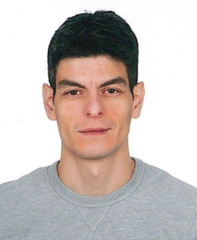Nanoimprinted high-frequency surface acoustic wave devices: generation, characterization and acousto-electric transport
Promotion date: March 20.
Promotor: Prof.dr.ir. Wilfried van der Wiel
| Surface acoustic waves (SAWs) are widely used and very important in both research and industry. In piezoelectric materials, they can be excited through the inverse piezoelectric effect, by using interdigital transducers (IDTs). There is a strong demand for higher frequencies. This thesis deals with the excitation and characterization on SAWs, as well as with SAW-induced charge transport by using an electrical excitation method. A method to fabricate sub-100nm structures, by using a planarization technique, is introduced. Ultrahigh IDTs on a ZnO/SiO2/Si multilayer system were fabricated and electrical characterization was performed. The highest resonance frequency reported here was 16.1 GHz. SAW devices up to 23.5 GHz were fabricated on SiO2/ZnO/SiO2/Si. Oscillating piezoelectric fields accompanying SAWs were used to demonstrate carrier transport along micrometer distances in GaAs nanowires, including indium-doped recombination centers. |
Was your research application driven?
Coming to resolutions below 100 nm, using new fabrication techniques, is a real challenge in which a lot of fundamental aspects still need to be studied. As a good example serves the surface interactions taking place in ultrahigh frequency interdigital transducers.
We were able to generate surface acoustic waves on silicon based devices well above twenty GHz. In cell phones, a few GHz is the standard nowadays. The possibility to generate these waves with a technique that is compatible with current Si-technology is both attractive and very exciting for real life applications.
Instead of using common photolithography methods, we used a further elaborated technique based on UV-based nano-imprint lithography. This technique uses a pre-patterned transparent stamp, to push a low viscous (almost liquid) material to be hardened out by UV and to replicate this pattern on a surface. By removing strategically parts on the substrate surface, using reactive ion etching, we were able to reach new critical dimensions. The lift-off process of undesired regions, to get the final device, was a central issue in this.
Another issue of my thesis involved acoustic electron transport. The short wavelength of the acoustic modulation traveling in nanowires, allows the trapping of photo-generated electrons and holes in a SAW-induced electric potential. Some applications are thinkable in the future: for the production of single photon sources, single charge control for quantum information technology, and in new probing methods for specialized research applications.
That sounds impressive. In what journals did you present your findings?
Two articles appeared in Nanotechnology, one in Applied Physical Letters. Also an article was published in the Journal of Vacuum Science and Technology B.
When I was a master student in Izmir, Turkey, I already published some papers. Here my first motivation originated, for becoming a PhD student. Academics fits me best, as I am very curious as a person. Right now I am looking for a post-doc position. In future I might switch to industry, to be able to perform more applied research. Nevertheless, I wish for a strongly research orientated job then.
In what way did you develop during this PhD period as a researcher?
I am much more independent now as a researcher. For example, one has to learn from literature searches, and decide for a logical and realistic research and experimentation path from there. This cannot be learned in a short period of time. One has to experience these challenges multiple times, to find successful strategies, leading to results worth publishing.
How did you experience working for Mesa+?
I was in the cleanroom many times. Here I interacted with fellow-PhD’s solving most of the problems in a friendly collaboration atmosphere. Colleagues and technicians helped me a great deal to overcome problems in the fabrication process.
What is important for Mesa+ to stay successful in future in your opinion?
The success of Mesa+ is obvious, as the institute covers the entire range of research: from fundamental to fabrication, prototyping, production and even commercialization. This is very important for spin-off’s and already existing companies.
Making use of the cleanroom, special arrangements were not always accessible. Sometimes difficulties arose to organize these arrangements in the busy cleanroom schemes. Regular meetings including cleanroom staff and the research groups can improve this, I believe.
Secondly, most of the research at Mesa+ is silicon based. New fields and new materials have a great potential for Mesa+, I believe. I wonder if a graphene or III-V semiconductor based research can be developed here in MESA+? That would be exciting!

